Location
On the west side of the cemetery, to the east of the Civilians memorial.
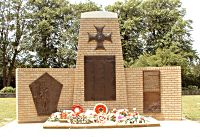
Detail - Right Plaque
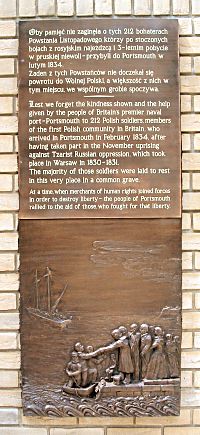
Detail - Top Plaque
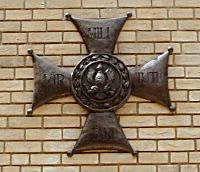
Detail - Centre Plaque
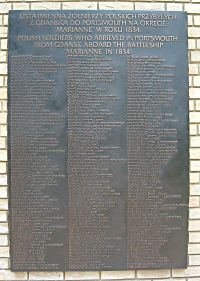
Detail - Left Plaque

Powstania Listopadowego którzy po stoczonych
bojach z rosyjskim najezdzcą i 3-letnim pobycle
w pruskiej niewoli- przybyli do Portsmouth w
lutym 1834.
Żaden z tych Powstańców nie doczekał się
powrotu do Wolnej Polski, a większość z nich w
tym miejscu, we wspólnym grobie spoczywa.
_______________
Lest we forget the kindness shown and the help
given by the people of Britain's premier naval
port - Portsmouth to 212 Polish soldiers, members
of the first Polish community in Britain, who
arrived in Portsmouth in February 1834, after
having taken part in the November uprising
against Tzarist Russian oppression, which took
place in Warsaw in 1830 - 1831.
The majority of those soldiers were laid to rest
in this very place in a common grave.
At a time when merchants of human rights joined forces
in order to destroy liberty - the people of Portsmouth
rallied to the aid of those, who fought for that liberty.
Inscription - Centre Plaque
Z GDAŃSKA DO PORTSMOUTH NA OKRĘCIE
"MARIANNE" W ROKU 1834:
POLISH SOLDIERS, WHO ARRIVED IN PORTSMOUTH
FROM GDANSK ABOARD THE BATTLESHIP
"MARIANNE" IN 1834
[212 names - See Below]
Further Information
1830 saw the beginning of an uprising in Warsaw by the Poles against their Russian oppressors. In 1831 this was defeated and many Polish soldiers escaped to Prussia. This was not a wise move as Prussia was already under the control of their Russian neighbours and so were forced to send the soldiers either to exile in Siberia or by ship to America. They chose the latter.
The exiles sailed from Gdansk aboard the ship "Marianne" and headed out for America but a few days later storms forced the ship to take cover in Portsmouth. The Captain had no intention of staying any longer than necessary but the Poles demanded to be let ashore. This did not go down well with the local magistrate who petitioned the Prime Minister, Lord Melbourne, for funds to support the soldiers. Lord Melbourne was equally unsympathetic and suggested returning the men back to Prussia.
The matter soon came to a head, with all official bodies refusing to take responsibility on the grounds that it would encourage further mass immigration. It was at this point that the people of Portsmouth took it upon themselves to help the men. Schools in Portsmouth made collections and held charity events to raise money for the relief of the soldiers with the result that by the time a refuge in Algeria had been obtained for the men, they did not want to go.

The Original Memorial c2002
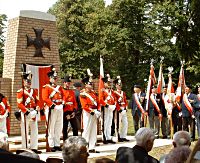
The Unveiling - 27 June 2004
As time passed the soldiers learned English, found employment, married local women, anglicized their names and obtained housing in the Aldwell Street area (now Winston Churchill Avenue).
A memorial to the Polish Soldiers was proposed 40 years ago and got as far as laying the brick superstructure and commissioning the plaques. Money then ran out, building work ceased and the plaques remained in the storerooms of the Portsmouth City Architects office. In 2004, the Polish Memorial Fund succeeded in raising funds to complete the work. Appositely the new memorial was designed by the chief architect at Portsmouth City Council, Stefan Jakobek, whose father fought in Warsaw in 1944 before moving to England.
The Chairman of the Polish Memorial Fund is Otton Z. Hulacki and he can be contacted at 18 Coppins Bridge, Newport, Isle of Wight, PO30 2BX. Tel: 01983 883340.
| NAMES ON THE CENTRAL PANEL | ||
|
ADAMKIEWICZ Tadeusz - 4 p.p.l. |
JOZWOWICZ Jozef - 12 p.p.l. |
PIETRZAK Lukasz - 4 p.p.l. |
Note: The right plaque on the memorial states there were 212 soldiers. There are actually 213 names on the central plaque as the wife of one of the men (LASTOWIECKA Juliana) is also listed.
